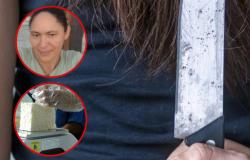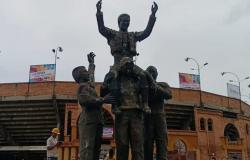The relationship of San Rafael with Córdoba is different from that of the rest of the world, both because the celebration of the custodian is celebrated in the capital on a different day than the one marked by the saints, and because the triumphs found throughout the city have a iconography different from the rest of the images of the archangel.
Saint Raphael is traditionally represented in connection with the biblical story of Tobiaswhile in Córdoba the model is that of Father Roelas, as explained to EFE by Juan José Roig, author of the book ‘The Triumphs of San Rafael’, published by Almuzara.
The Archangel Saint Raphael appeared to Father Roelas on four occasions when he prayed for his health and it was, in the early morning of May 7, 1578, when the fifth and last apparition occurred in which Saint Raphael told the priest: ” I swear to you, by Jesus Christ crucified, that I am Raphael, angel whom God has appointed to guard this city.”
Although this is the iconography used in the triumphs that pay tribute to the archangel, devotion to the custodian, who is not the patron of the city, began three centuries earlier when San Rafael freed the capital of Cordoba from a plague epidemic.
After suffering this devastating epidemic, the city of Córdoba found support in the Church, the nobility and the municipal council, who came together, in gratitude, to erect numerous triumphs to San Rafael, of which Roig gives an account in this book, counting the details and singularities of each of these custodians.
This journey, as recorded in this book, began in 1651, with the construction of the first triumph, and culminated in 2014, with the completion of the last one.
One less victory because of a storm
A 372-year history of Córdoba’s own iconography that places Saint Raphael at the top of a pedestal with his characteristic nimbus, dressed in a tunic, carrying the pilgrim’s staff, a cape or cloak and leggings up to mid-calf. In one hand he holds a fish and in the other, the cartouche with the oath declaring him the custodian of the city.
In Córdoba there are eleven triumphs of San Rafael, one less since last year, as a result of Storm Bernard, a tree fell and destroyed the one that was in the Plaza del Cristo de Gracia and that has not yet been restored.
Of all of them, “the triumph par excellence for the people of Córdoba”, according to Roig, is the one found on the Roman Bridge of Córdoba, which was the first to be placed and does not respect the classical iconography as it does not have a pedestal, and behind it It was the one located in the Plaza de la Compañía.
There are numerous anecdotes regarding these sculptures spread throughout the city, such as, for example, that the one found in Puerta Nueva, which was originally going to be a fountain and not a triumph, and which still preserves three bullets from when General Dupont He entered Córdoba in 1808.
The compilation of the history of the triumphs of San Rafael came to the author when, after his retirement as an emergency doctor, he dedicated himself to exploring Córdoba and on one of his walks he began to notice the different triumphs that can be found in the streets. from the capital of Cordoba.
The uniqueness of San Rafael in Córdoba
His first idea, as he has confessed, was to make a video about these sculptures but he discovered “that there was already one made by the brotherhood of San Rafael, so it no longer made sense”, so he looked at the faces of the statues and He decided to focus on them.
The explanation that none of the triumphs have the same expression on their faces is another of the unique characteristics that these images have: “And it is not that they do not have the same face, it is that some of them over time have changed his head”, sometimes up to three times.
Roig has emphasized the uniqueness of the triumphs in the capital of Córdoba, since, “there are many in Europe but in Spain they are not so frequent, only in Córdoba and in a few other places.”
Benefits destined for the Diocese of Bangassou
‘The triumphs of San Rafael’ is prefaced by the bishop of Bangassou, Juan José Aguirre, who assures that this book is “a guide. First you read it and then you can go as a couple or as a family, and you will discover one each triumph, listening to their little story and putting each one in its historical frame.
The profits from the sale of the book will be destined for the diocese of Bangassou, for whose bishop “San Rafael is the collective memory of our ancient city and in its shadow all the pages of this book are sheltered.”
You may also like






